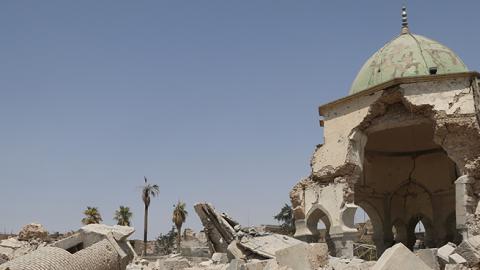Executive Summary
p(firstLetter). The fight in Iraq and Syria against the brutal terrorist organization Islamic State (ISIS) has been led by an unprecedented international coalition, with the U.S. as the galvanizing diplomatic and military component. ISIS was defeated militarily in Iraq at the end of last year, but even today small pockets remain as a fighting force in Syria.
As the war is won, peace must be secured. Key to that effort is post-conflict stabilization through restoration of essential services and a gradual return of governance. As the U.S. National Security Strategy puts it, “instability and weak governance threaten U.S. interests.” In Iraq and Syria, reasserting stability is vital so that terrorist organizations do not find fertile ground again.
This report draws some lessons from Iraq and Syria on stabilization efforts and the path forward. The backdrop is the evolving U.S. approach to stabilization under the Trump administration. On June 19, 2018, the administration published the final version of the Stabilization Assistance Review report, which provides an inter-agency definition of stabilization, including a more hard-nosed approach to sharing the burden with partners in accordance with President Trump’s priorities. The review also draws demarcation lines between humanitarian assistance, stabilization, and reconstruction. Stabilization is short-term and transitional, and thus also limits the time frame for U.S. engagement. However, the U.S. no longer provides public funding for reconstruction to avoid nation-building, which the administration has declared to be off limits.
In Iraq, initial post-conflict stabilization was relatively successful. The UN, led by the United Nations Assistance Mission for Iraq (UNAMI), directed the efforts in tight coordination with the anti-ISIS coalition. The coalition’s military efforts in Mosul were adjusted to identify how many internally displaced persons (IDPs) could be accommodated in a day, which was typically no more than 10,000. Another way of measuring UNAMI’s stabilization accomplishment is in the rate of return of displaced persons, which has been relatively high, with over 3.2 million by the start of 2018. UNAMI also managed to successfully pool donor resources through the Funding Facility for Stabilization (FFS), which employs local workers and thus provides community growth as well.
Yet even though post-conflict stabilization is still taking place in Iraq, the next phases loom. Stabilization is generally a bridge to longer-term political reconstruction and reconciliation. The “by, with, and through” approach of the anti-ISIS coalition created the foundation for an Iraqi-owned victory over Da’esh. The resulting local pride and unity can at best serve as a new foundation for reconstructing and reconciling Iraq.
At worst, the many divisions in Iraq—from the political exclusion of Sunnis, which helped give rise to ISIS in Iraq, to the restoration of the minorities of the Nineveh plains, who face enduring challenges—will recreate fault lines. The U.S. Agency for International Development (USAID) is now aiming to disperse assistance directly to these groups, including Christians, to restore communities. Moreover, the situation in Iraqi Kurdistan is equally tense, requiring sustainable compromises. Kirkuk, the disputed city, is one priority within the Kurdish question, particularly given that the Iraqi constitution envisions a governance process for the city. For the U.S., the level of continuing Iranian influence is likely to affect the U.S. engagement and conversely affect how willing the Iraqi government will be to continue security cooperation with the U.S. including accepting U.S. soldiers on Iraqi soil.
The Iraqi government has moved into the reconstruction phase through the Kuwait Reconstruction Conference for Iraq, held in February 2018, at which the U.S. administration’s novel approach to burden-sharing was put into practice. The U.S. did not provide public money for Iraqis and instead nudged other countries to contribute more, including European and Gulf partners. Still, the U.S. has continued generous contributions to humanitarian aid and stabilization.
For donor countries to sustain influence, reconstruction funding should be tied to government reforms and, more importantly, to tangible progress on reconciliation and political accommodation efforts.
In Syria, post-conflict stabilization has been political and fraught from its inception, since the U.S. and its anti-ISIS coalition partners do not want to engage and work with Bashar al-Assad’s central government. The same approach of “by, with, and through” has been applied—but in Syria there have been greater challenges. This is because the local partner of necessity, the Syrian Democratic Forces (SDF), is closely tied to the Syrian Kurdish People’s Protection Units (YPG), a group that Turkey perceives as a direct extension of the Kurdistan Workers’ Party (PKK), which is listed as a terrorist organization. For the U.S. and other Western allies, military and stabilization collaboration with the SDF in Raqqa has complicated relations with Turkey. The dynamic has also contributed to Turkey’s own incursion into Afrin, as it establishes its version of “stabilization” in these areas.
On the other hand, for the U.S., it was the 2016 defeat of ISIS in Manbij, where no post-conflict stabilization plan had been drawn up, which prompted stabilization preparation for Raqqa and the surrounding areas. Prior to Raqqa’s downfall, State Department and USAID officials set up camp near Tabqa and tested nimble, small-scale operations to prepare for restoration of essential services and mine clearing.
There is no doubt about the necessity of post-conflict stabilization in Raqqa. The city was symbolically important for ISIS as its capital. Therefore, it is equally symbolically important to render Raqqa stable enough for refugees and IDPs to return and for the city not to become a breeding ground or refuge for extremism again. Around 100,000 people have returned to Raqqa, but ongoing demining and the lack of essential services continue to make conditions perilous. The question is whether political will can last long enough to sustain stabilization funding, and whether partners can step up to improve the burden-sharing as the U.S. continues its pivot away.
Additionally, stabilization is intrinsically linked to the broader question of political transition and governance, which remains unresolved in Syria. It was part of then Secretary of State Rex Tillerson’s Syria strategy in January to combine these priorities. The fact that forces friendly to the U.S. hold up to 30 percent of Syria’s territory was seen as leverage for political talks. This approach seems more uncertain now with Trump’s April announcement of a U.S. military withdrawal from Syria, even if it is not carried out immediately, combined with his focus on working with Russia in Syria, which seems uninterested in any genuine political transition. Russia’s lack of commitment to the southwest de-escalation zone, even though agreed between Trump and President Putin, seems a good litmus test of how much—or little—the U.S. can get out of cooperating with Russia in Syria. The Trump-Putin summit in Helsinki was also vague on specifics regarding Syria.
The press release for the Stabilization Assistance Review report specifically highlights “aligning stabilization efforts toward supporting defined political outcomes.” Thus, stabilization efforts in Raqqa might not be sustainable if divorced from a larger political and diplomatic strategy.
Another major challenge for stabilization in Raqqa is Kurdish military and civilian dominance through the SDF and the Raqqa Civilian Council (RCC), which creates the potential for conflict with the majority Sunni Arab local population. There are already reports of such local clashes. One way to mitigate conflict would be to hold local elections to guarantee better inclusion of Sunnis. The U.S. could also encourage the Syrian Kurds to devolve authority to Arabs and local tribes. These measures could gradually reduce the geographical expanse of Kurdish-controlled territory. In addition, they could potentially prevent the YPG from using the future status of Raqqa as a bargaining chip in negotiations with the Assad regime and Russia. Pursuing such a strategy would obviously present a new challenge for the U.S. in getting Kurdish buy-in.
Simultaneously, and more broadly, the U.S. and other anti-ISIS coalition partners could engage the Kurdish Democratic Union Party (PYD) and its armed wing, the YPG, on changing the party’s structure and irreversibly severing links with the PKK, thus creating long-term options for reconciliation between Turkey and these groups of Syrian Kurds. Turkish by now well-established relations with the Iraqi Kurds (the Kurdistan Regional Government, or KRG) demonstrate that enmity between Turks and Kurds is not inevitable.
All such moves demand a certain element of predictability and U.S. staying power. It was somewhat surprising, then, that President Trump announced in April that the U.S. military should depart Syria. That decision has been put on hold, particularly since the military fight against ISIS is not over. A hasty U.S. withdrawal would make it very difficult to achieve aims associated with stabilization even if other partners step up, such as Saudi Arabia's additional commitment of $100 million in August.
Trump froze a portion of stabilization funding for Syria, perceiving it as nation-building, which he deems unnecessary and believes that other countries should pay for. Ultimately, this makes it harder to get the displaced back into their homes.
In conclusion, in both Iraq and Syria, post-conflict stabilization has continued to be part of the U.S. policy response. The report of the Stabilization Assistance Review codifies this through a narrower approach to stabilization and acknowledges that there is “no appetite to repeat large-scale reconstruction efforts.” Yet it also states that stabilization is inherently political.
This is evident in Iraq, where successful stabilization still must show that it can translate into successful reconciliation and reconstruction, considering regional and national political dynamics.
This is evident in Syria, where the end state of the country emerging from war is still uncertain, making it hard to know if stabilization will translate into long-term advances.
And it is evident inside the U.S. administration, where President Trump’s willingness to go a step further and freeze stabilization funding in Syria calls into question the framework and distinctions that the review was erecting as U.S. policy.















